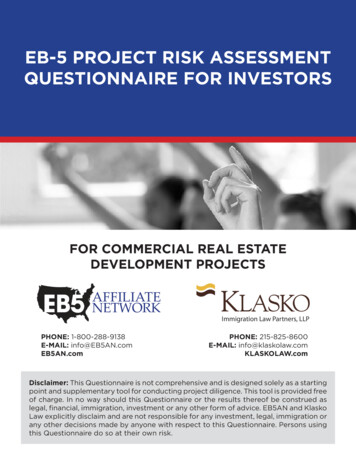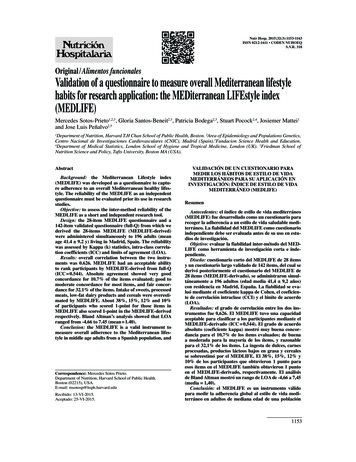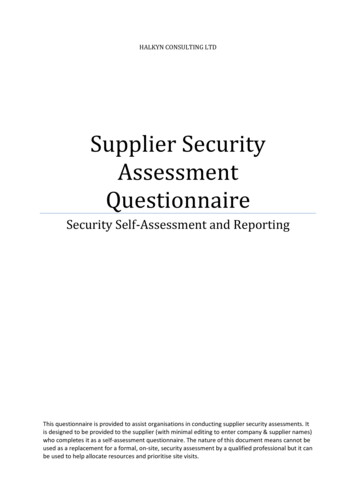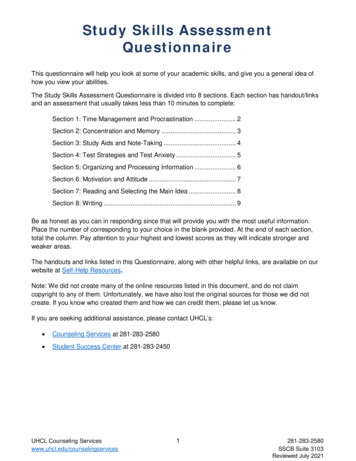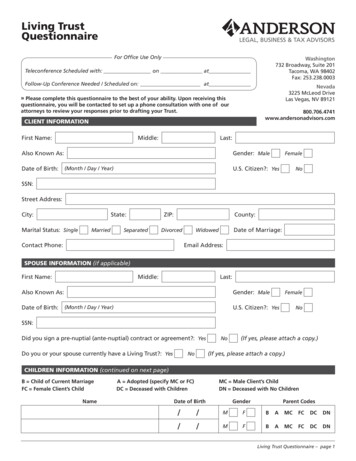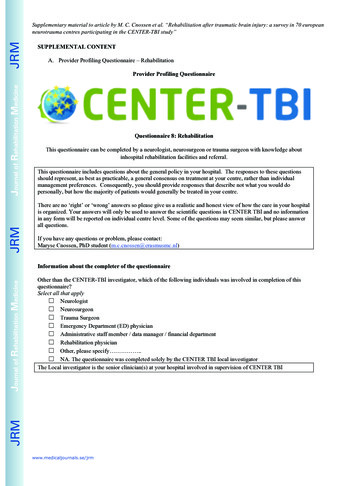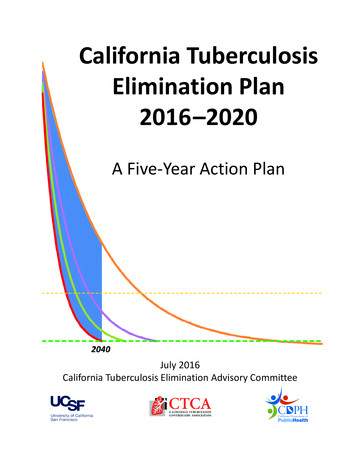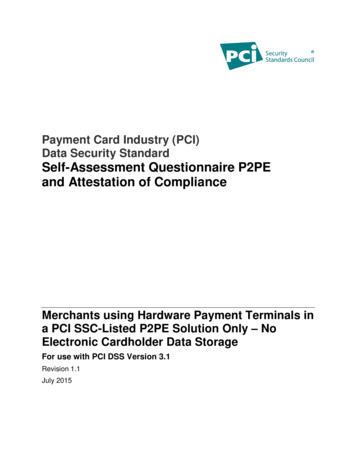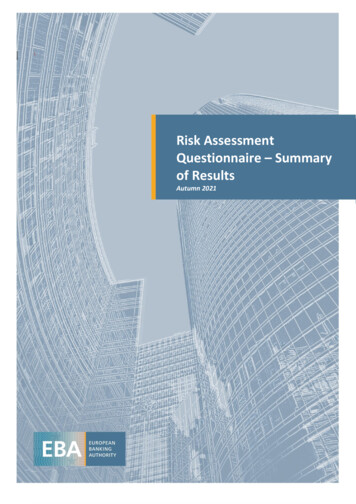
Transcription
Risk Assessment Questionnaire (RAQ)\Risk AssessmentQuestionnaire – Summaryof ResultsAutumn 20211
Risk Assessment Questionnaire (RAQ)ContentsIntroduction3Summary of the main results4Banks’ questionnaire71.Business model / strategy / profitability72.Funding / liquidity203.Asset composition & quality254.Conduct, reputation, and operational risk335.FinTech386.ESG407.General open question42Market analysts’ questionnaire431.Business model / strategy / profitability432.Funding / Liquidity483.Asset composition & quality504.General Questions58Annex: List of EU banks involved in current RAQ survey59Appendix: Risk Assessment Questionnaire for banks61Appendix: Risk Assessment Questionnaire for market analysts622
Risk Assessment Questionnaire (RAQ)IntroductionThe EBA conducts semi-annual Risk Assessment Questionnaires (RAQs) among banks and marketanalysts. This booklet presents a summary of the responses to the RAQs carried out in Autumn 2021,in which 59 banks 1 and 8 market analysts submitted their answers. Results of the survey werereceived by September 2021. The RAQ results are published together with the EBA’s quarterly RiskDashboard (Q3 2021).The results of the survey are presented in an aggregated form. The survey questionnaires areavailable in the Appendices. Charts numbers correspond to the question numbers in thequestionnaires. Where relevant, answers from former questionnaires may be presented. Forquestions for which only one answer was permitted, any potential difference between the sum ofshown responses and 100% is due to respondents answering either “n/a” or “no opinion”. In thesummary of the main results, most figures are rounded.Should you wish to provide your feedback on this booklet, please do so by contactingrast@eba.europa.eu1Please see Annex for the list of banks participating in the survey.3
Risk Assessment Questionnaire (RAQ)Summary of main findingsThe impact of the COVID-19 pandemic on the macroeconomic environment and the ongoinguncertainty continued to be a source of concern for banks and analysts in the Autumn 2021 RiskAssessment Questionnaire (RAQ). Other issues pointed to in the survey include low bankprofitability, risk of increasing NPLs, rising operational and ESG related risks and Fintech challenges.Business model, strategy, and profitability The share of responding banks that reply they are covering their cost of equity (CoE) hasincreased to 50%, up from 35% in the previous RAQ. More than 70% of them estimate their CoEat a range between 8% and 12%. Improvements in bank profitability are expected by 80% ofbanks (up from 75% in the previous RAQ) and 50% of market analysts (20% in the previous RAQ).Banks aim to increase the income from fees and commissions and to reduce operating expenses.More than 80% of banks consider rising market yields will affect their profitability positively.(Question 3, 4, 5, 6, and 8 for banks and Question 1 for market analysts) Around 60% of banks consider, or have considered, mergers and acquisitions (M&A), slightlymore than in previous surveys. Banks primarily consider transactions involving domesticbusiness units and/or portfolios (70%) but also domestic credit institutions, and creditinstitutions, business units and/or portfolios in other EU/EEA countries (55%). Market analystsconsider complexity and regulatory requirements the main obstacles for banking consolidationwhile for banks the lack of business opportunities is the main deterrent factor. (Question 1 forbanks and Question 4 for market analysts)Funding and liquidity The survey replies indicate that over the coming 12 months banks will focus their funding onsenior non-preferred/senior HoldCo (more than 50%) and preferred senior unsecured debt(35%). A smaller share of banks reports their intention to draw secured funding (covered bonds)(25% from 20% in Spring 2021 and 15% in Autumn 2020). The share of banks intending to attainmore central bank funding has sharply decreased from 20% in the previous survey to just 5%.This contrasts with the analysts’ views in which a growing share - 65% vs 40% in the previousRAQ - expect banks to attain more central bank funding. (Question 11 for banks and Question5 for market analysts)4
Risk Assessment Questionnaire (RAQ) Around 40% of banks identify pricing as the main constraint when issuing MREL eligibleinstruments, while 35% suggest there are no constraints. 20% of them consider they havealready attained enough MREL, more than double compared to the previous survey. (Question12 for banks) The percentage of banks charging negative rates to non-financial corporations (NFCs)continued to rise (60% vs 55% on the previous survey). In contrast, the share of them chargingnegative rates to households’ deposits remains stable at comparatively low levels (15%). Inparallel, an increasing share of banks report charging higher fees for NFC deposits or currentaccounts and related services, as reaction to the current low and negative interest rateenvironment. Nevertheless, the share of banks applying higher fees to households as responseto this environment decreased slightly to 35%. (Question 13 for banks)Asset volume trends and asset quality Banks plan to increase both residential mortgage lending as well as lending to corporates andsmall and medium enterprises (SME). Market analysts point to an expected increase inconsumer lending albeit with a lower percentage of agreement than in the previous RAQ (75%vs 80%, respectively). (Question 15 for banks and Question 7 for market analysts) A lower share of banks expects a deterioration in asset quality. SME and consumer credit arethe portfolios for which banks are more pessimistic. Nonetheless, the percentage of bankspointing to a deterioration of these portfolios have declined steeply compared to the previousRAQ (from 70% to 35% for SME lending, and from 65% to 35% for consumer credit). Marketanalysts are particularly concerned about commercial real estate (CRE) lending (90% of themexpect a deterioration of this portfolio). (Question 16 for banks and Question 8 for marketanalysts) Banks have reduced their cost of risk (CoR) estimation for the current financial year. While inthe previous RAQ 35% of banks expected a CoR below 50 bps, this percentage has doubled to70% in the latest survey. At the same time, the share of banks that expect their CoR to exceed100 bps has decreased compared to the previous survey (15% from 25% in Spring 2021). Inaddition, the COVID-19 overlay applied by 75% of the banks (45% in the previous RAQ) does notexceed 25% of the total CoR. (Question 17 and 18 for banks)Conduct, reputation, and operational risk A significant share of banks expects an increase in operational risk (55%), in line with previoussurveys. Banks consider cyber risk and data security issues as the reasons for the expectedincrease in operational risk (90%). This is followed by conduct and legal risk (42%). In relation tomoney laundering and terrorist financing (ML/TF) risk, banks see payment settlements and retailbanking as the business lines where this risk is expected to increase the most in the next 6 to 12months. (Question 22 and 23 for banks)5
Risk Assessment Questionnaire (RAQ)Fintech Regarding the adoption of innovative technologies, 70% of banks declared that they arealready using digital wallets, cloud computing, big data analytics and artificial intelligence (AI),including biometrics. However, the adoption of newly emerging technologies, such as smartcontracts and distributed ledger technology, is limited. While more than 30% of banks are usingDLT solutions, exploration of smart contracts continues with 15% of banks already using them.As a result of COVID-19, the majority (60%) plans to increase their investment in IT upgrades andmaintenance, and digital innovation. A smaller proportion of them (20%) aim to increaseinvestments in non-bank FinTech firms/start-ups. (Questions 25 and 26 for banks)ESG Banks reported that ESG factors are widely considered in their risk management. 80% of banksare taking them into account in credit risk, while more than 70% of banks consider them forreputational and operational risks. Far fewer institutions consider ESG factors in other riskcategories. (Question 27 for banks) Common methodologies to assess ESG risks include the exposure method using ESG scores orratings, adopted by 55% of banks, the risk framework method (including scenario analysis orstress testing) (50%), and the portfolio alignment method (45%). (Question 28 for banks) The metrics most used by banks to assess their exposures to climate-related risks are carbonor greenhouse gas (GHG) financed emissions and environmental scores/ratings ofcounterparties (both indicated by 45% of banks). They are followed by the share of greenexposures (40%) and the share of environmentally harmful exposures (30%). (Question 29 forbanks)General open question Risks stemming from the ongoing Covid-19 pandemic and its impact on economic activities aswell as the uncertainty over its evolution continue to be source of concern for banks. Banksalso point to concerns about increasing cyber risks and the broader macroeconomic situation,including a potential slowdown in economic growth. Several banks also mentioned the lowinterest rate environment and climate risk. (Question 31 for banks)6
Risk Assessment Questionnaire (RAQ)Banks’ questionnaire1. Business model / strategy / profitabilityQuestion 1: Autumn 2021 results7
Risk Assessment Questionnaire (RAQ)Question 1: Comparison with earlier results8
Risk Assessment Questionnaire (RAQ)9
Risk Assessment Questionnaire (RAQ)Question 2: Autumn 2021 resultsQuestion 2: Comparison with earlier results10
Risk Assessment Questionnaire (RAQ)Question 3: Autumn 2021 resultsQuestion 3: Comparison with earlier results11
Risk Assessment Questionnaire (RAQ)Question 4: Autumn 2021 resultsQuestion 4: Comparison with earlier results12
Risk Assessment Questionnaire (RAQ)Question 5: Autumn 2021 resultsQuestion 5: Comparison with earlier results13
Risk Assessment Questionnaire (RAQ)Question 6: Autumn 2021 resultsQuestion 6.1: Autumn 2021 results14
Risk Assessment Questionnaire (RAQ)Question 6: comparison with earlier results15
Risk Assessment Questionnaire (RAQ)Question 7: Autumn 2021 resultsQuestion 7: comparison with earlier results16
Risk Assessment Questionnaire (RAQ)Question 8: Autumn 2021 results17
Risk Assessment Questionnaire (RAQ)Question 9: Autumn 2021 resultsQuestion 9: comparison with earlier results18
Risk Assessment Questionnaire (RAQ)Question 10: Autumn 2021 resultsQuestion 10: comparison with earlier results19
Risk Assessment Questionnaire (RAQ)2. Funding / liquidityQuestion 11: Autumn 2021 resultsQuestion 11: comparison with earlier results20
Risk Assessment Questionnaire (RAQ)Question 12: Autumn 2021 resultsQuestion 12: comparison with earlier results21
Risk Assessment Questionnaire (RAQ)Question 13: Autumn 2021 resultsQuestion 13: Comparison with earlier results22
Risk Assessment Questionnaire (RAQ)Question 14: Autumn 2021 results23
Risk Assessment Questionnaire (RAQ)Question 14: comparison with earlier results24
Risk Assessment Questionnaire (RAQ)3. Asset composition & qualityQuestion 15: Autumn 2021 resultsQuestion 15: comparison with earlier results25
Risk Assessment Questionnaire (RAQ)Question 16: Autumn 2021 resultsQuestion 16: comparison with earlier results26
Risk Assessment Questionnaire (RAQ)Question 17: Autumn 2021 resultsQuestion 17: comparison with earlier results27
Risk Assessment Questionnaire (RAQ)Question 18: Autumn 2021 resultsQuestion 18: comparison with earlier results28
Risk Assessment Questionnaire (RAQ)Question 19: Autumn 2021 resultsQuestion 19: comparison with earlier resultsQuestion 20: Autumn 2021 results29
Risk Assessment Questionnaire (RAQ)Question 20: comparison with earlier results30
Risk Assessment Questionnaire (RAQ)Question 20.1: Autumn 2021 results31
Risk Assessment Questionnaire (RAQ)Question 20.1: comparison with earlier results32
Risk Assessment Questionnaire (RAQ)4. Conduct, reputation, and operational riskQuestion 21: Autumn 2021 resultsQuestion 21: comparison with earlier results33
Risk Assessment Questionnaire (RAQ)Question 22: Autumn 2021 resultsQuestion 22: comparison with earlier results34
Risk Assessment Questionnaire (RAQ)Question 22.1: Autumn 2021 resultsQuestion 22.1: comparison with earlier results35
Risk Assessment Questionnaire (RAQ)Question 23: Autumn 2021 results36
Risk Assessment Questionnaire (RAQ)Question 24: Autumn 2021 resultsQuestion 24: comparison with earlier results37
Risk Assessment Questionnaire (RAQ)5. FinTechQuestion 25: Autumn 2021 resultsQuestion 25: comparison with earlier results38
Risk Assessment Questionnaire (RAQ)Question 26: Autumn 2021 resultsQuestion 26: comparison with earlier results39
Risk Assessment Questionnaire (RAQ)6. ESGQuestion 27: Autumn 2021 resultsQuestion 28: Autumn 2021 results40
Risk Assessment Questionnaire (RAQ)Question 29: comparison with earlier resultsQuestion 30: Autumn 2021 results41
Risk Assessment Questionnaire (RAQ)7. General open questionQuestion 31: Autumn 2021 results42
Risk Assessment Questionnaire (RAQ)Market analysts’ questionnaire1. Business model / strategy / profitabilityQuestion 1: Autumn 2021 resultsQuestion 1: Comparison with earlier results43
Risk Assessment Questionnaire (RAQ)Question 2: Autumn 2021 resultsQuestion 2: Comparison with earlier results44
Risk Assessment Questionnaire (RAQ)Question 3: Autumn 2021 resultsQuestion 3.1: Autumn 2021 results45
Risk Assessment Questionnaire (RAQ)Question 3: comparison with earlier resultsQuestion 3.1: comparison with earlier results46
Risk Assessment Questionnaire (RAQ)Question 4: Autumn 2021 resultsQuestion 4: comparison with earlier results47
Risk Assessment Questionnaire (RAQ)2. Funding / LiquidityQuestion 5: Autumn 2021 resultsQuestion 5: comparison with earlier results48
Risk Assessment Questionnaire (RAQ)Question 6: Autumn 2021 resultsQuestion 6: comparison with earlier results49
Risk Assessment Questionnaire (RAQ)3. Asset composition & qualityQuestion 7: Autumn 2021 resultsQuestion 7: comparison with earlier results50
Risk Assessment Questionnaire (RAQ)51
Risk Assessment Questionnaire (RAQ)Question 8: Autumn 2021 resultsQuestion 8: comparison with earlier results52
Risk Assessment Questionnaire (RAQ)53
Risk Assessment Questionnaire (RAQ)Question 9: Autumn 2021 resultsQuestion 9: comparison with earlier resultsQuestion 9.1: Autumn 2021 results54
Risk Assessment Questionnaire (RAQ)Question 9.1: comparison with earlier results55
Risk Assessment Questionnaire (RAQ)Question 10: Autumn 2021 resultsQuestion 10: comparison with earlier results56
Risk Assessment Questionnaire (RAQ)Question 11: Autumn 2021 resultsQuestion 11: comparison with earlier results57
Risk Assessment Questionnaire (RAQ)4. General QuestionsQuestion 12: Autumn 2021 results58
Risk Assessment Questionnaire (RAQ)Annex: List of EU banks involved in currentRAQ surveyFinancial InstitutionCountryBAWAG GroupErste Group Bank AGRBIBelfius BankKBC GroupFirst Investment Bank ADBank of CyprusHellenic BankDanske Bank A/SNykredit Realkredit GroupAS LHV PankNordea Bank AbpOP Financial GroupBNP PARIBAS S.A.CONFEDERATION NATIONALE CREDIT MUTUEL (CNCM)CREDIT AGRICOLE SAGroupe BPCELa Banque PostaleSociete GeneraleCommerzbank AGDeutsche Bank AGDZ BANK AG Deutsche Zentral-GenossenschaftsbankHelaba - Landesbank Hessen-ThüringenLandesbank Baden-WürttembergNORD/LB Norddeutsche Landesbank - GirozentraleALPHA BankEurobank S.A.NATIONAL BANK OF GREECEPIRAEUS FINANCIAL HOLDINGS S.A.OTP Bank Nyrt.Allied Irish Banks PlcBank of IrelandLandsbankinn ryIrelandIrelandIceland59
Risk Assessment Questionnaire (RAQ)Financial InstitutionBanca Monte dei Paschi di Siena SpaBanco BPM SpABPER Banca S.p.A.INTESA SANPAOLOUniCredit S.p.A.Banque et Caisse d'Epargne de l'EtatBank of Valletta plcABN AMROCooperatieve Rabobank U.A.ING Groep N.V.DNB Bank ASASpareBank 1 SR-Bank ASABank Pekao S.A.PKO Bank Polski S.A.Banco Comercial Português S.A.Caixa Geral de Depósitos, S.A. (CGD)BANCA TRANSILVANIANova Ljubljanska bankaBanc Sabadell, S.A.BANCO BILBAO VIZCAYA ARGENTARIA, S.A.BANKINTER, S.A.CAIXABANK, S.A.Santander GroupSEBSvenska Handelsbanken ABSwedbank he NetherlandsThe NetherlandsThe denSweden60
Risk Assessment Questionnaire (RAQ)Appendix: Risk Assessment Questionnairefor banks[added on the following pages]61
EBA Risk Assessment Questionnaire for Banks - Autumn 2021Fields marked with * are mandatory.Respondent information* Financial Institution* CountryLEI code of financial institutionText of 20 to 20 characters will be accepted* Contact e-mail addressI agree with EBA privacy noticeEBA Privacy notice 2021.pdfPlease note the EBA RAQ booklet, which summarises the aggregate results of the survey (see the last version), will again include alist of participating banks (no bank by bank results or similar will be disclosed).”Business model/strategy/profitability* Q1 Are you considering (or have you considered) M&A transactions?a) Yesb) No1
* Q1.1 if Yes, are you potentially considering M&A transactions with/of?a) Domestic business units and/or portfoliosb) Domestic credit institutionsc) Credit institutions, business units and/or portfolios in other EU/EEAd) Credit institutions, business units and/or portfolios from outside the EU/EEAe) Fintech firms (domestic or foreign).f) Non-bank financial service providers* Q1.2 if No, what are the main reasons for not considering M&A transactions? (please do not agreewith more than 2 options)at most 2 choice(s)a) Complexitye) Regulatory requirements and supervisorystance/actions/viewb) Cost and riskiness of such transactionsf) Lack of business cases/opportunitiesc) Cultural aspectsg) Not envisagedd) Lack of transparency on asset quality of thepotential partners* Q2 What is the minimum return on equity (ROE) level that your bank needs to operate on a longerterm basis?a) 6%d) 10% and 12%b) 6% and 8%e) 12% and 14%c) 8% and 10%f) 14%* Q3 Are your current earnings (ROE) covering the cost of equity?a) Yesb) Noc) No Opinion* Q4 What is your Cost of Equity estimation?a) 6%d) 10% and 12%b) 6% and 8%e) 12%c) 8% and 10%* Q5 Do you expect an overall increase in your bank's profitability in the next 6 to 12 months?a) Yesb) Probably Yesc) Probably Nod) Noe) No OpinionQ6 Which areas do you primarily target to increase profitability of your bank in the next 6 to 12months? (ranking according to priority with 1-High Priority and 4-Low Priority)2
at least 6 answered row(s)1234N/A* a) Net interest income* b) Net fee and commission income* c) Other operating income* d) Operating expenses / costs reduction* e) Impairments* f) Other* Q6.1 If you rank net interest income with (1) or (2), what are the main areas to increase net interestincome? (please do not agree with more than 2 options)at most 2 choice(s)a) increasing lending volumesb) focusing on higher risk assets (e.g. consumer finance, commercial real estate, SME, CLOs)c) reducing funding costsd) Other* Q7 Which measures are you primarily taking to reduce operating expenses / costs? (please do notagree with more than 3 options)at most 3 choice(s)a) Overhead and staff costsd) Reducing business activities (business lines andreductionlocations, incl. branches)b) Outsourcinge) Increasing automatization and digitalisationc) Off-shoring or near-shoringf) Other* Q8 How do you expect rising market yields to affect your bank’s profitability in the next 6 to 12months?a) Very positive impactb) Rather positive impactc) Rather negative impactd) Very negative impacte) No impact* Q9 In which areas is your bank working on solutions for the replacement of IBOR benchmark rates(EONIA, LIBOR etc.)?a) Related to new business (e.g. issuance of new funding instruments with variable rates referringto new / alternative risk free rates)b) Related to existing business (e.g. preparing the change of existing contracts, replacing existingIBOR references to alternative ones)3
c) Related to the bank's internal operations, capabilities and systems (e.g. valuation models)d) Not applicableQ10 In which area would you currently see the biggest challenges and potentially the biggest risksin your preparations in view of the IBOR agreeNoOpinion* a) Related to existing business onthe asset side (e.g. variable rateloans)* b) Related to existing funding (e.g.debt securities issued with variablerates)* c) Related to other existinginstruments / business (e.g.derivatives)* d) Related to new business (e.g.newly issued debt securities, variablerate loans or derivatives)* e) Related to changes in the bank'sinternal operations, capabilities andsystems (e.g. valuation models)* f) Do not see any big challenges / bigrisks related to the IBORreplacements.Funding/liquidity* Q11 In the next 12 months, which funding instruments do you intend to focus on? (please do notagree with more than 2 options)at most 2 choice(s)a) Preferred senior unsecured fundingg) Deposits (from retail clients)b) Senior non-preferred / Senior HoldCoh) Central Bank funding (medium and long-fundingterm)c) Subordinated debt including AT1/T2i) Short-term interbank fundingd) Secured funding (covered bonds)j) CET1 instrumentse) Securitisationsk) Not applicablef) Deposits (from wholesale clients)* Q12 Which are the main constraints to issue instruments eligible for MREL? (please do not agreewith more than 2 options)at most 2 choice(s)4
a) Pricing (e.g. spread between MREL-eligible and MREL-ineligible instruments)b) No sufficient investor demand (e.g. these instruments are not attractive in risk-returnconsiderations)c) No sufficient investor demand due to regulatory and supervisory uncertaintyd) Uncertainty on required MREL amounts and their compositione) Uncertainty on eligibility of instruments for MRELf) Have already attained sufficient amounts of MREL-eligible instrumentsg) There are no constraints* Q13 In the current low and negative interest rate environment, which of the following actions haveyou taken in relation to deposits?a) Charging negative rates to household deposits or current accountsb) Charging negative rates to non-financial corporate deposits or current accountsc) Charging higher fees for household deposits or current accounts and related services (e.g.payments or transfer of funds, direct debits, standing orders, annual or monthly fee, issuance feefor debit card etc)d) Charging higher fees for non-financial corporate deposits or current accounts and relatedservices (e.g. payments or transfer of funds, direct debits, standing orders, annual or monthly fee,etc)e) None of the above* Q14 What are your main considerations for avoiding to charge negative rates? (please do not agreemore than 2 options)at most 2 choice(s)a) Legal clarity (e.g. legal restrictions on negative deposit rates)b) Reputational issuesc) A preference for charging higher feesd) Competition from other banks and non-bankse) Preserving the stability of the deposit basef) Official interest rates are positiveg) Not applicableAsset composition and qualityQ15 Which portfolios do you plan to increase/decrease in volume during the next 12 months (on anet basis)?IncreaseDecreaseStableNoOpinion* a) Commercial Real Estate (including all types of realestate developments)* b) SME* c) Residential Mortgage5
* d) Consumer Credit* e) Corporate* f) Trading* g) Structured Finance* h) Sovereign and institutions* i) Project Finance* j) Asset Finance (Shipping, Aircrafts etc.)* k) OtherQ16 Which portfolios do you expect to improve/deteriorate in asset quality in the next 12 months?ImproveDeteriorateRemainNoStableOpinion* a) Commercial Real Estate (including all types ofreal estate developments)* b) SME* c) Residential Mortgage* d) Consumer Credit* e) Corporate* f) Trading* g) Structured Finance* h) Sovereign and institutions* i) Project Finance* j) Asset Finance (Shipping, Aircrafts etc.)* k) Other* Q17 What is your Cost of Risk (change in allowances and provisions as a ratio of total loans andadvances subject to impairment) estimation for the current financial year?a) 0bpb) 0 and 25bpc) 25 and 50bpd) 50 and 75bpe) 75 and 100bpf) 100 and 150bpg) 150 and 200bph) 200 and 250bp6
i) 250bp* Q18 Of the above amount, how much is estimated due to the COVID-19 overlay, i.e. the part of the2021 cost of risk which will be considered through additional management judgement and is due toCOVID-19?a) 25%b) 25% and 50%c) 50% and 75%d) 75%* Q19 What are your most common strategies for NPL reduction and to prevent built-up of NPL(please do not agree with more than 2 options)?at most 2 choice(s)a) Hold and forbearance based strategies (i.e. holding NPLs and applying suitable workoutstrategies and forbearance options)b) Active portfolio reductions: sales (e.g. NPL and other portfolio transactions)c) Active portfolio reductions: NPL securitisationsd) Change of type of exposure or collateral (e.g. foreclosure, debt to equity, debt to asset swaps,collateral substitution)e) Legal options (e.g. insolvency proceedings, out-of-court solutions)* Q20 Are there any impediments to resolve non-performing loans (stock and new flow)?a) Yesb) No* Q20.1 If Yes, what are the main impediments for your institution to resolve non-performing loans?(please do not agree with more than 2 options)at most 2 choice(s)a) Lack of capitalb) Lack of qualified human resourcesc) Tax disincentives to provision and write off NPLsd) Inefficient legal framework and judiciary process to resolve insolvency and enforce on collateral(please do not agree with more than 2 options)e) Lack of out-of-court tools for settlement of minor claimsf) Lack of a market for NPLs/collateralsg) Lack of public or industry-wide defeasance structure (bad bank)h) Preference to resolve NPL at a later stagei) Otherj) Not applicable (i.e. there is no need to resolve NPLs)Conduct, Reputational and Operational risk* Q21 Since the end of your Financial Year 2007/8, how much has your firm paid out in the form ofcompensation, redress, litigation and similar payments [converted to EUR, aggregate amount]?7
a) EUR 100me) EUR 5bn and EUR 10bnb) EUR 100m and EUR 500mf) EUR 10bn and EUR 20bnc) EUR 500m and EUR 1bng) EUR 20bnd) EUR 1bn and EUR 5bn* Q22 Do you see an increase in operational risk in your bank:a) Yesb) Noc) No Opinion* Q22.1 If applicable, what are the main drivers for increasing operational risk is (please do not agreewith more than 3 options):at most 3 choice(s)a) Cyber risk and datag) Organisational changesecurityb) IT failuresh) Breaches of anti-money laundering and counter terrorismfinancing obligationsc) Outsourcingi) Breaches of applicable restrictive measures (financialsanctions)d) Regulatory initiativesj) Fraude) Conduct and legal riskk) Otherf) Geopolitical riskQ23 How do you expect your ML/TF risk exposure related to the following products / business linesto evolve in the next 6 to 12 months?IncreaseDecreaseNo impact* a) Corporate finance* b) Trading and sales* c) Retail banking* d) Commercial banking* e) Payment and settlement* f) Agency services* g) Asset management* h) Retail brokerage* i) Other* Q24 What permanent organisational changes are now in place as response to the COVID-19 crisis?a) Reductions of the branch networkb) More telework arrangementsc) Enhanced splitting up of the teams in critical units and setting-up of new locations8
d) Outsourcing functions and services to third-party providerse) In/re-sourcing from offshored activities (i.e. from Asia back to the EU)f) Increased investments in IT infrastructure and systemsg) Change/adapt business lines and product offeringh) OtherFinTech*Please note that for the purposes of this questionnaire FinTech is defined as ‘Technologicallyenabled financial innovation that could result in new business models, applications, processes, orproducts with an associated material effect on financial markets and institutions and the provisionof financial services’ (Financial Stability Board).Q25 What budgetary changes are you planning from Q2 2021 onwards as a result of eincreaseNodecreasedecrease(more than(10% orchange(10% or(more10%)less)less)than 10%)* a) Investment in non-bankFinTech firms/start-ups (e.g.acquisitions, participations,venture capital)* b) Spending on IT upgrade andmaintenance* c) Spending on digital innovation/new technologiesQ26 What is the level of involvement of your institution with the application of the followingtechnologies?In use sionactivity* a) Cloud computing* b) Digital/Mobile wallets* c) Distributed Ledger Technology* d) Big Data analytics (defined as theuse of advanced analytic techniquessuch as machine learning, againstvery large, diverse data sets fromdifferent sources, and in differentsizes.)* e) Biometrics9
* f) Artificial Intelligence (includingmachine learning and naturallanguage processing)* g) Smart contractsQ26.1 If 'In use / launched' or 'Pilot testing', please list some actual use cases/applications of thesetechnologies. (OPEN ENDED QUESTION)a) Cloud computingb) Digital/Mobile walletsc) Distributed Ledger Technologyd) Big Data analytics (defined as the use of advanced analytic
Banks reported that ESG factors are widely considered in their risk management. 80% of banks are taking them into account in credit risk, while more than 70% of banks consider them for reputational and operational risks. Far fewer institutions consider ESG factors in other risk categories. (Question 27 for banks)
